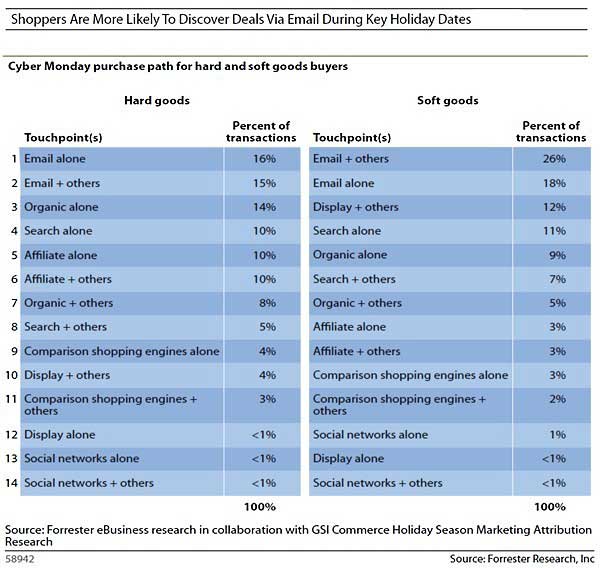Email and search marketing still have the greatest influence on consumers' online buying behaviors, whereas social media, though it generates awareness, is rarely associated with direct revenue, according to a study by Forrester Research and GSI Commerce.
Most online consumers are influenced by Web marketing messages: 77% of buyers of hard-goods items (e.g., sporting goods, toys/games, and health/beauty products) during the 2010 holiday season interacted with some type of marketing tactic prior to purchase.
Similarly, 82% of buyers of soft-goods items (apparel and accessories) during the same period were influenced by digital marketing before making a purchase.
Moreover, roughly one-half of holiday purchases followed multiple exposures to Web marketing efforts: 45% and 53% of hard- and soft-goods transactions, respectively, touched at least two marketing touch-points.
Below, other findings from The Purchase Path of Online, conducted by Forrester Research on behalf of GSI Commerce.
Search and Email's Influence
Search and email were the most effective tactics in driving sales during the holidays: On average, 39% of hard-goods transactions and 60% of soft-goods transactions arrived to retail websites via email and search:
- In the hard-goods category, 22% of holiday transactions started with email and 17% started with search.
- Among buyers of soft-goods, 37% of transactions started with email; 23% started with search.
The above data exclude purchases made during the peak, promotional periods of Thanksgiving weekend and Cyber Monday.
During those peak periods, search is less effective, since consumers are more likely to look for great deals rather than specifically hunt for products. During such periods, consumers are also more likely to respond to email offers.
Cyber Monday Activity
That trend is particularly apparent in the soft-goods category. For example, 44% of soft-goods transactions on Cyber Monday started with an email, whereas only 18% started with search.
Similarly, search accounted for only 14% of hard-goods transactions on Cyber Monday, whereas email accounted for 31%.

Social tactics were largely in ineffective in driving direct sales: Less than 2% of orders were a result of shoppers arriving via social network.
Even so, roughly 7% of consumers say they learned about 2010 Cyber Monday deals via Facebook, Twitter, and other social networking sites.
Although hard-goods retailers in this study experienced no change in the number of orders that resulted from links from social sites, soft goods retailers experienced a 45% lift in orders resulting from social links on Cyber Monday (vs. the rest of the holiday season).
Looking for solid, substantiated information about email from the industry's best resources? The 67-page Email Marketing Factbook featuring 39 charts tells you about email usage, what captures users' attention, and how organizations are using email to reach customers. This email factbook consists of chapters 1 & 2 from the larger Digital Marketing Factbook a 144-page compilation of data and 110 charts that also covers search engine marketing and social media.
Attributing Credit to Display, Affiliates
Display and affiliate marketing influence the purchase funnel. For example, display ads are the first touch-point for roughly 12% of soft-goods buyers on Cyber Monday, but those shoppers then click on other marketing messages, which ultimately receive "credit" for the sale, according to the report.
Most retailers employ "last-click" analysis, so any tactic that is primarily "first click" is likely to be undercounted in its contribution to sales. Similarly, because of the last-click attribution framework, affiliates (3%) may be undervalued in ROI analyses.
Read more about the report on the Forrester and GSI Commerce Tweet Jam.
About the data: Findings are based on a click-stream analysis of 15 online retailers (clients of GSI Commerce) together representing roughly $1 billion in gross merchandise sales in 2010. Data was captured from Nov 12 to Dec 20; Thanksgiving weekend data was captured from 12 am on Nov 25 through 11:59 pm on Nov 28; and Cyber Monday data was captured on Nov 29, 2010.



